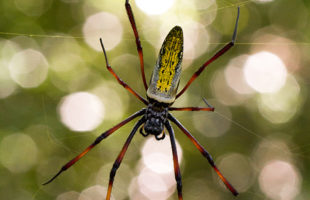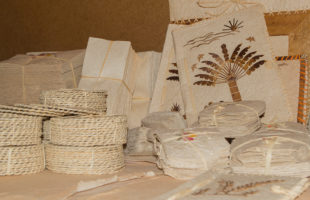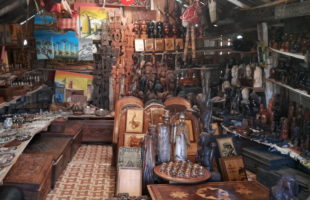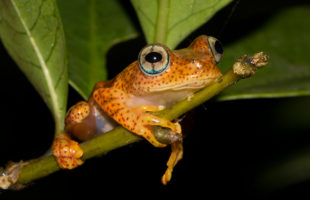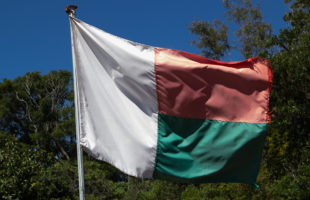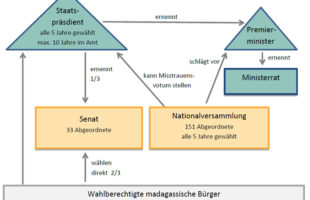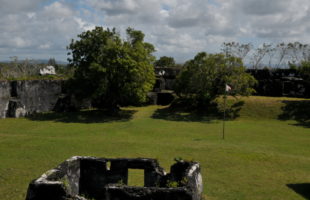Reniala: The name means as much as “mother of the forest”, which is the nickname of the baobabs endemic to this area. Location: Deep down at the southwestern coast of Madagascar, about 30 km away from the big city Toliara (Tuléar), there is the small village Ifaty-Mangily directly at the sea. You can reach it since 2016 via a well-paved …
LesenMasika sipa
The Red-legged Golden Orb-web Spider
Most travelers are more frightened by the sight of a spider, but the Red-Legged Golden Orb-Web Spider (Trichonephila inaurata madagascariensis) can teach some people otherwise. The female, including her legs, is as big as a human hand, the body is black with a golden-yellow, white-grey lined stripe on the back, the legs are broadly striped in black and red. The …
LesenAntemoro paper
Actually, the Antemoro ethnic group lives in southeast Madagascar, around Manakara and Farafangana. In the southern highlands, however, there is a small factory in the middle of Ambalavao, which still shows the production of the handmade paper called Antaimoro, which was once typical of the traditional Antemoro and still is today. Originally the Antemoro came from Arabs, who brought the …
LesenThe way of chocolate: Growing cocoa
Originally, the cocoa plant (Theobroma cacao, meaning „deities‘ dish“) does not come from Madagascar, but from Southern America. Yet the eighth continent offers best preconditions to cultivate cocoa. Today, Madagascan cocoa is considered one of the best available in the world. Accordingly, the harvest is very small: with an average of 3000 tons per year, Madagascar accounts for less than …
LesenChez Joseph
Antsirabe, one of the largest cities in the southern highlands of Madagascar and only 170 km from the capital Antananarivo, is not only known for its thermal springs. Antsirabe has been a meeting place for gemstone dealers and jewellers for years due to the numerous sapphire mining areas a little further south. If you are looking for a special gemstone …
LesenHandcrafts’ market of Tana
Antananarivo, Madagascar’s capital, is not only full of life, but also full of markets. One of those is the handcrafts‘ market Andravoahangy on Route Digue, located few kilometres from Ivato airport. Hundred of artisans merged together here to the biggest handcrafts’ market of the country, which offers really everything the heart could wish for. Boothes side by side make a …
LesenThe not really fiery red frog
Madagascar’s dense, mystical rainforests offer a home to countless endemic (i.e. only here occurring) animals. Among them is a particularly colorful representative of the Madagascar frogs, a frog with the scientific name Boophis pyrrhus (from Greek pyrrhos = fire red). It can be found on the east coast and in the southern highlands of Madagascar, from Soanierana Ivongo near the …
LesenMadagascar’s national flag
Madagascar’s national flag carries the colours white, red and green (white vertically in the left two fifths, red and green horizontally in the right three fifths of the flag). It was introduced on 21.10.1958 with Madagascar’s independence as the official national flag. It was preceded by a competition to create a new national flag. In 2009, the various proposals of …
LesenPolitical system
Madagascar currently has a semi-presidential system of government and is officially a democratic republic called “Republic of Madagascar”. The President is elected directly every five years by Malagasy citizens. However, he may run for office no more than twice, i.e. for a maximum of ten years. The President appoints the Prime Minister (who must be sent by the National Assembly) …
LesenFort Manda
The ruin of Fort Manda is about three kilometres northeast of the coastal town of Mahavelona (Foulpointe) and can be easily reached by foot from there. Directly from the end of the town it is only half as far. A visit should take at least half a day, the entrance fee is about 3000 Ariary. Fidel, the guide and guardian …
Lesen MADAMAGAZINE Your Magazine about Madagascar
MADAMAGAZINE Your Magazine about Madagascar


